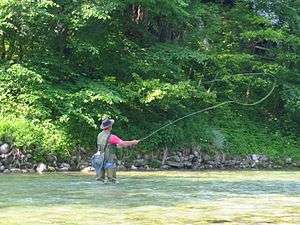Rough fish
Rough fish (or the slang trash fish) is a term used by U.S. state agencies and U.S. anglers to describe fish that are less desirable to sport anglers within a limited region. The term usually refers to larger fish species that are not commonly eaten, are too rare to be commonly encountered, or are not sought after by anglers for sporting purposes. Many of these species are very important in the commercial fishing industry, where they make up the bulk of commercial food fish catches in inland fresh waters.[1]
Subjectivity
There is no standard list of rough fishes. A fish that is considered a rough fish in one region may be considered a desirable game and food fish in another, often due to cultural differences or simply tradition. For example, the common carp is considered an undesirable rough fish in the United States and Australia, but is the premier game fish of Europe and the most valuable food fish across most of Asia. Likewise, the longnose gar is considered a rough fish and undesirable nuisance in Ohio. In Louisiana, though, it is considered tasty by certain ethnic groups and, due to the many small bones, is rarely filleted, but rather is usually rolled with seasonings into "gar balls" and fried.[2]
Native versus exotic
Some rough fishes are exotic species that have been transplanted into North American waters from other continents either intentionally or unintentionally (for example, the common carp). Other rough fishes are native species that can be confused with carp because they look similar (bigmouth buffalo, smallmouth buffalo, and suckers). Many of these fishes are difficult to process as food because of their many bones. Still other rough fishes are native fishes completely unlike carp, but are categorized as such because they are underused or unpopular.[3]
Origin of the term
The first reference to the term "rough" as applied to fish is in the historical work "A History of Fish and Fishing on the Upper Mississippi River" by Carlander. To summarize: In the mid-to-late 19th century, commercial fishermen in the Central United States often netted and processed large quantities of river fish in their boats for sale, particularly in the Mississippi River. They would then travel many miles up or down river to deliver these fish to market. In hot summer weather, the slow, heavily loaded boats often had to be lightened quickly to ensure that the entire catch did not become spoiled before reaching market. The common practice of the time was to save the fully processed fish, since these commanded a higher price at market. Rough-dressed fish (or fish sold "in the rough" - which means they had the internal organs removed but were not filleted) were discarded to lighten the boat, by dumping the carcasses into the river. Thus, originally a "rough fish" was a fish of any species that had been only partly processed and which could not be sold for full price. The term subsequently evolved into a derogatory term for any fish that was undesirable or unpopular.[1]
Variations
The term coarse fish is used in Europe to describe all fishes besides trout and salmon, but it is not a derogatory term.[3] The Minnesota Department of Natural Resources has made efforts to replace the term "rough fish" with "underused fish"[4] The slang term "trash fish" is used in some areas, but it is a derogatory term and not accepted by most working directly in the industry, including fishermen.
Prospects
Many rough fish species are federally endangered, threatened, candidate, or species of concern. These native American fishes have limited and declining populations and are at risk of extinction. Because of this, they are listed under the Federal Endangered Species Act.[5] Some rough fishes listed by the US Fish and Wildlife Service are:
- Blue sucker (Cycleptus elongatus)[6]
- Razorback sucker (Xyrauchen texanus)[7]
- Robust redhorse (Moxostoma robustum)[8]
- Cui-ui (Chasmistes cujus)[9]
- Gray redhorse (Moxostoma congestum)[10]
- Sicklefin redhorse (Moxostoma spp.)[11]
- Shortnose sucker (Chasmistes brevirostris)[12]
- Flannelmouth sucker (Catostomus latipinnis)[13]
- Greater redhorse (Moxostoma valenciennesi)[14]
- Colorado squawfish (pikeminnows - Ptychocheilus spp.)
- Roundtail chub (Gila robusta)
- Humpback chub (Gila cypha)
- Bonytail chub (Gila elegans)
See also
- Carp
- Bullhead catfish (Ameiurus)
- Drum
- Freshwater drum or Sheepshead
- Eel
- Gar
- Bowfin
- Sucker
- Sharks
- Achirus lineatus
Notes
- 1 2 Carlander HB (1954) A history of fish and fishing in the upper Mississippi River Upper Mississippi River Conservation Committee, University of California.
- ↑ Becker, George C. (1983) Fishes of Wisconsin Madison, Wisconsin: University of Wisconsin Press
- 1 2 Rob Buffler and Tom Dickson (1990) Fishing for Buffalo: A Guide to the Pursuit, Lore & Cuisine of Buffalo, Carp, Mooneye, Gar, and other "Rough" Fish Culpepper Press, Minneapolis
- ↑ Minnesota Fishing Regulation Booklet, 2010
- ↑ US Fish and Wildlife Service
- ↑ ESA Listing for Blue Sucker (Cycleptus elongatus)
- ↑ ESA Listing for Razorback Sucker (Xyrauchen texanus)
- ↑ ESA Listing for Robust Redhorse (Moxostoma robustum)
- ↑ ESA Listing for Cui-ui (Chasmistes cujus)
- ↑ ESA Listing for Gray Redhorse (moxostoma congestum)
- ↑ ESA Listing for Sicklefin Redhorse (Moxostoma sp.)
- ↑ ESA Listing for Shortnose Sucker (Chasmistes brevirostris)
- ↑ ESA Listing for Flannelmouth sucker (Catostomus latipinnis)
- ↑ ESA Listing for Greater redhorse (Moxostoma valenciennesi)
References
- Carlander HB (1954) A history of fish and fishing in the upper Mississippi River Upper Mississippi River Conservation Committee, University of California. Html version
- Rob Buffler and Tom Dickson (1990) Fishing for Buffalo: A Guide to the Pursuit, Lore & Cuisine of Buffalo, Carp, Mooneye, Gar, and other "Rough" Fish Culpepper Press, Minneapolis.
- Becker, George C. (1983) Fishes of Wisconsin Madison, Wisconsin: University of Wisconsin Press
- Minnesota Fishing Regulation Booklet, 2010
- US Fish and Wildlife Service Endangered Species Program


